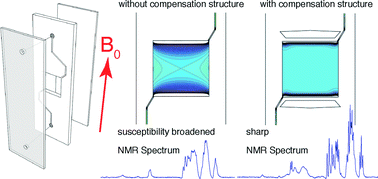Structural shimming for high-resolution nuclear magnetic resonance spectroscopy in lab-on-a-chip devices
Abstract
High-resolution proton NMR spectroscopy is well-established as a tool for metabolomic analysis of biological fluids at the macro scale. Its full potential has, however, not been realised yet in the context of microfluidic devices. While microfabricated NMR detectors offer substantial gains in sensitivity, limited spectral resolution resulting from mismatches in the magnetic susceptibility of the sample fluid and the chip material remains a major hurdle. In this contribution, we show that susceptibility broadening can be avoided even in the presence of substantial mismatch by including suitably shaped compensation structures into the chip design. An efficient algorithm for the calculation of field maps from arbitrary chip layouts based on Gaussian quadrature is used to optimise the shape of the compensation structure to ensure a flat field distribution inside the sample area. Previously, the complexity of microfluidic NMR systems has been restricted to simple capillaries to avoid susceptibility broadening. The structural shimming approach introduced here can be adapted to virtually any shape of sample chamber and surrounding fluidic network, thereby greatly expanding the design space and enabling true lab-on-a-chip systems suitable for high-resolution NMR detection.


 Please wait while we load your content...
Please wait while we load your content...